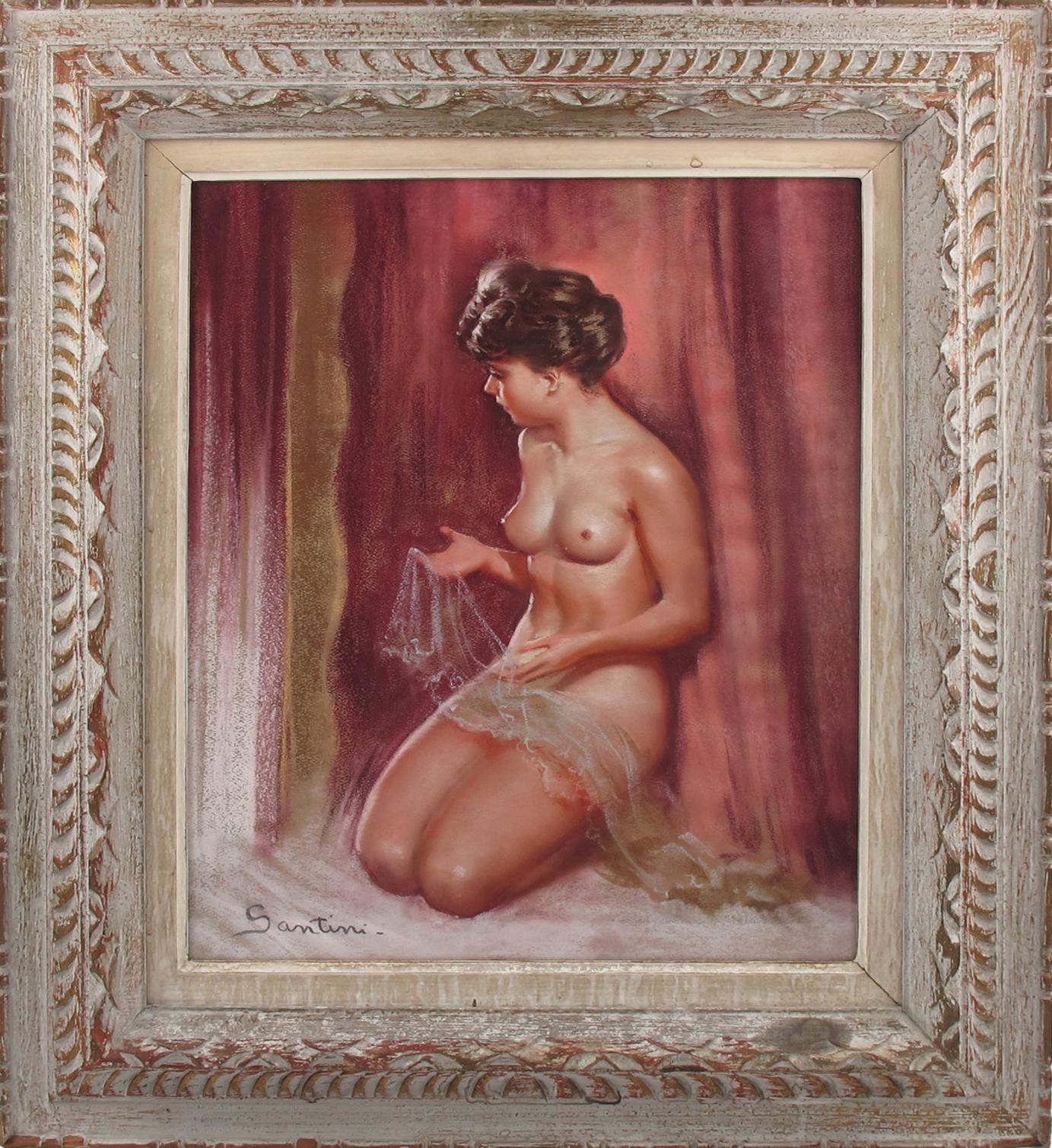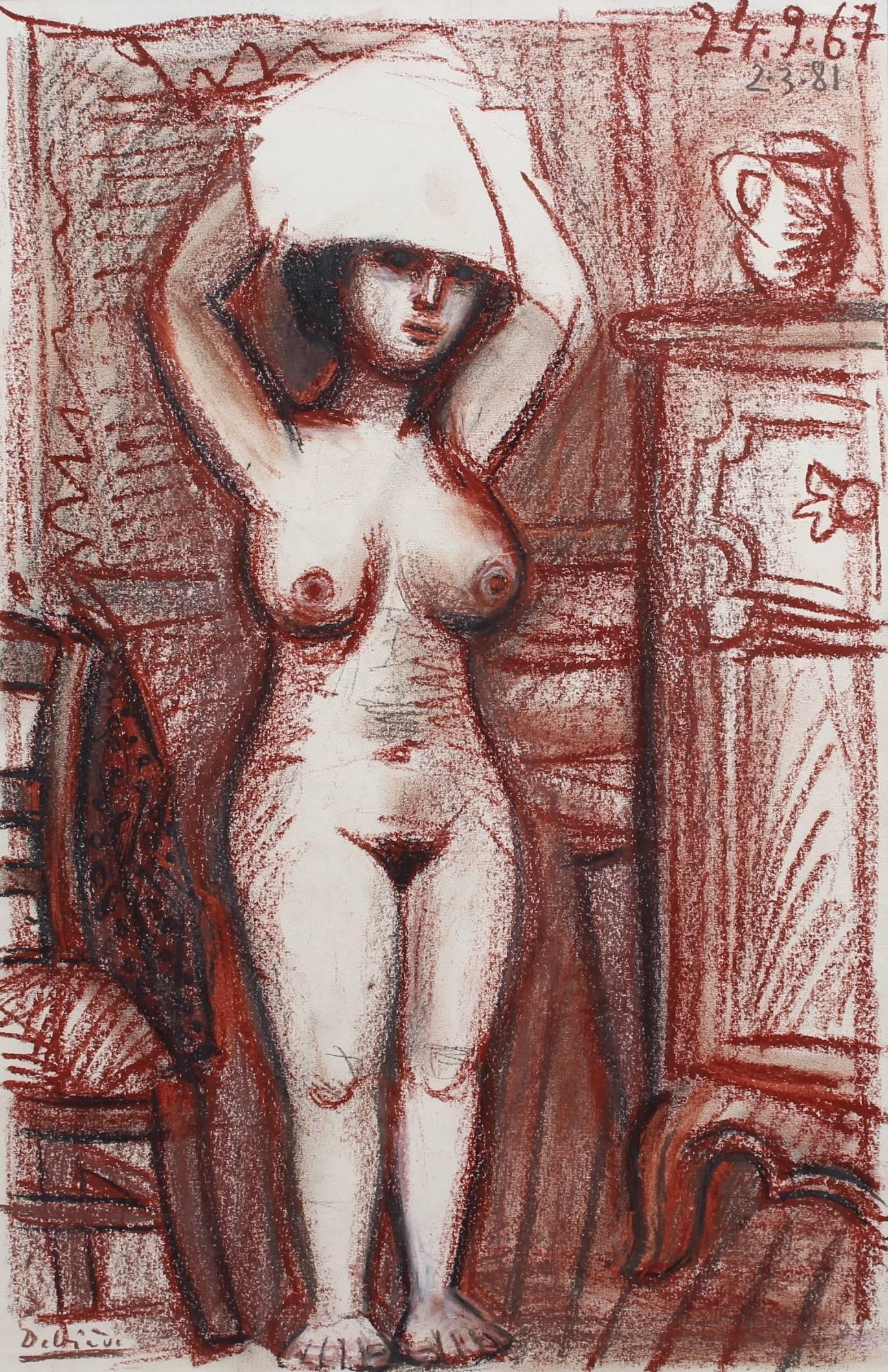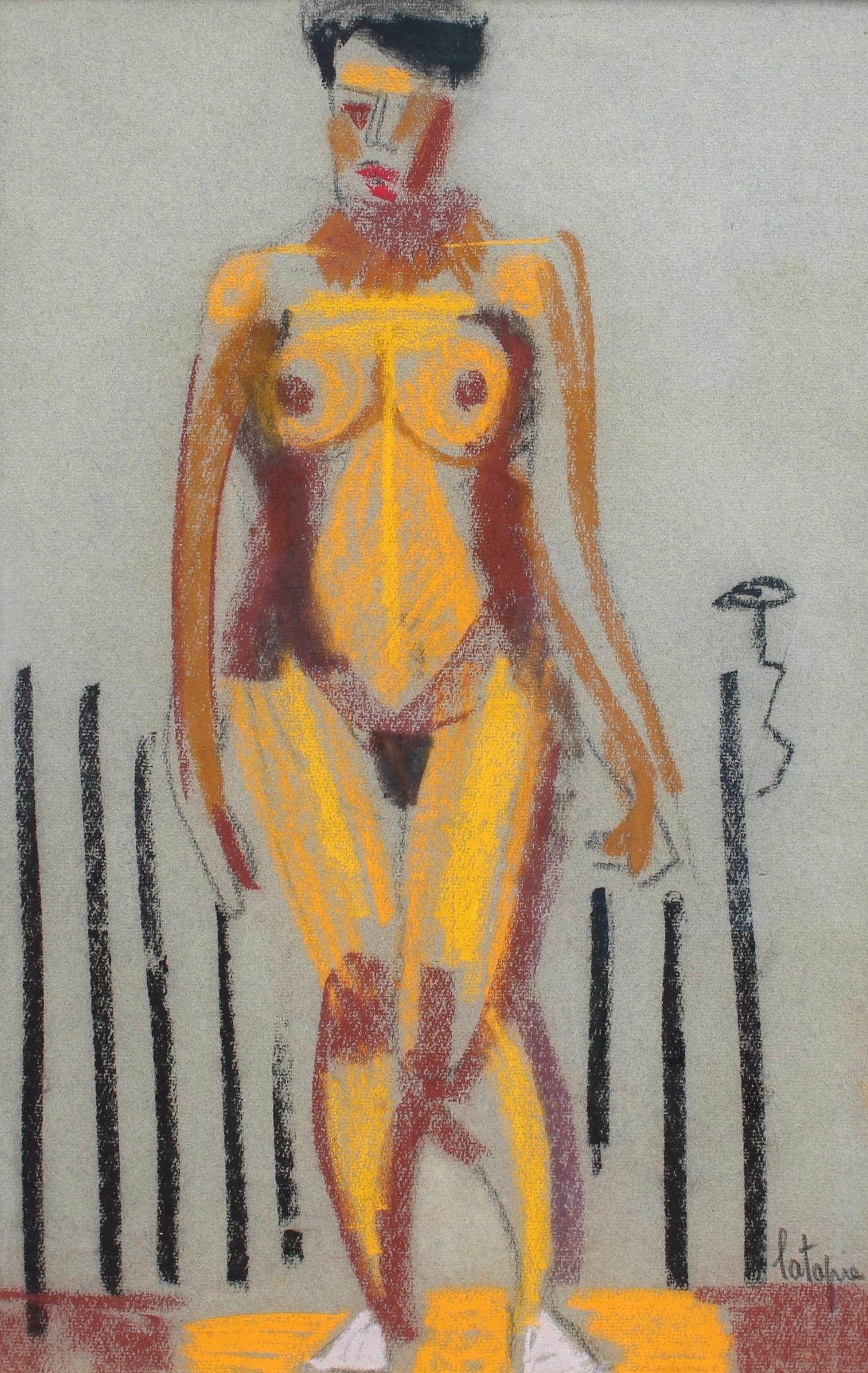Francisco ZúñigaFrancisco Zuniga Original Pastel Nude Painting Catalogued1975
1975
About the Item
- Creator:Francisco Zúñiga (1912 - 1998, Costa Rican)
- Creation Year:1975
- Dimensions:Height: 28.5 in (72.39 cm)Width: 34 in (86.36 cm)Depth: 1.6 in (4.07 cm)
- Medium:
- Movement & Style:
- Period:
- Condition:
- Gallery Location:Dallas, TX
- Reference Number:1stDibs: LU2724214287862
Francisco Zúñiga
Known as one of the most important Expressionist artists to emerge from Latin America, Francisco Zúñiga is remembered for his monumental sculptures, figurative paintings and prints, nude drawings and portraits of Central America’s rural indigenous women.
Born in San José, Costa Rica, in 1912, Zúñiga’s exposure to artistic sculpture began at the age of 13, when he worked with his father, Manuel Maria Zúñiga, carving religious figures for local churches. Spurred by a growing interest in art, Zúñiga attended San José’s School of Fine Arts, where he became influenced by classical, renaissance figurative art. After winning several local awards for his prodigious talent, Zúñiga left San José for Mexico City in 1936.
In Mexico City, he attended La Esmeralda, the painting and sculpture school of the National Institute of Fine Arts. There, Zúñiga studied under sculptor Oliverio Martinez and painter Manuel Rodriguez Lozano.
In 1938, Zúñiga joined the faculty at La Esmeralda, where he taught sculpture and painting until 1970. Meanwhile, during the early 1940s, Zúñiga’s works began to attract the attention of art critics in the United States as well as important collectors. In 1941, the Arts Club of Chicago included him as part of their “Thirteen Mexican Artists” group show. The following year, Alfred Barr, director of the Museum of Modern Art in New York, purchased one of his stone sculptures for MoMA’s permanent collection. Then, in 1943, New York’s Metropolitan Museum of Art acquired two of Zúñiga’s drawings.
Throughout most of his career, Zúñiga limited his subject matter to indigenous peasant women. However, he experimented with working with a variety of materials for his sculptures — bronze, alabaster, plaster, marble and modeling clay — and sought new media to create his art. (He made his first lithograph at age 60.)
Zúñiga won countless accolades in his lifetime. He won international awards for 35 of his public sculptures along with other works, and in 1992, he won Mexico’s highest cultural award, the Premio Nacional de Calidad.
Even after his death in 1998, Zúñiga’s legacy lives on. His sculptures, drawings, paintings and prints are found in museums around the world, including MoMA and the Met in New York, the Museum of Modern Art in Mexico City, the Fogg Museum at Harvard University, the Hirshhorn Museum and Sculpture Garden in Washington, D.C., the Middleheim Museum in Antwerp, Belgium and the Open-Air Museum in Hakone, Japan.
On 1stDibs, discover a range of Francisco Zúñiga prints, drawings and paintings.
- ShippingRetrieving quote...Ships From: Dallas, TX
- Return PolicyA return for this item may be initiated within 14 days of delivery.
- Andre Derain Female Nude Pencil DrawingBy André DerainLocated in Dallas, TXAndré Derain (1880-1954) nude female pencil drawing, circa 1935 Stamped with Atelier Oval “Andre Derain” Stamped on verso with the S. Knaublich André Derain sale stamp Pencil on pape...Category
1930s Aesthetic Movement Nude Paintings
MaterialsPaper
- Francisco Zuniga Original Painting “Brujeria”By Francisco ZúñigaLocated in Dallas, TXFrancisco Zuniga, Mexican (1912-1998). 'Brujeria', sepia and black charcoal on paper. I spoke with Ariel Zuniga and he was very impressed by this painting saying three or more figure...Category
1970s Aesthetic Movement Nude Paintings
MaterialsPaper
- Raoul Dufy Fauvist Art Deco Nude PaintingBy Raoul DufyLocated in Dallas, TXRaoul Dufy (French, 1877-1953) Nu allongé sur canapé, circa 1939 China ink, gouache, and watercolor on paper laid on board Sight: 16 x 19.75 inches (40.6 x 50.2 cm) Signed lower righ...Category
1930s Art Deco Nude Paintings
MaterialsPaper
- Henri Matisse Crayon Drawing Direct from Matisse EstateBy Henri MatisseLocated in Dallas, TXHenri Matisse (French 1869-1954) Pencil Drawing Of A Working Horse Catalogued as Number Z 548 in the Artist Archives Pencil on paper, c. 1900, signed with initials 'HM' lower right....Category
Early 1900s Modern Abstract Paintings
MaterialsPaper, Crayon
- Emile Albert Gruppe Bringing In The Nets 30x36By Emile Albert GruppeLocated in Dallas, TXEmile Albert Gruppe (1896-1978) Hauling in the nets Oil on canvas Signed lower right: Emile A. Gruppe 30" H x 36" W A large and important classic by Gruppe of the Gloucester nautica...Category
1950s American Modern Landscape Paintings
MaterialsOil
- Emile Albert Gruppe Important Fall Landscape 40x30By Emile Albert GruppeLocated in Dallas, TXEmile Albert Gruppe (1896-1978) Fall landscape Oil on canvas laid to canvas Signed lower right: Emile A. Gruppe Canvas: 40" H x 30" W Inches Framed: 48.25 x 38.25 Inches Very large ...Category
1940s American Modern Landscape Paintings
MaterialsOil
- 1960s "Hanging on a Bar" Gouache and Pastel Mid Century Female Nude PaintingBy Gloria DudfieldLocated in Arp, TXGloria Dudfield Hanging on a Bar 1960's Gouache and Oil Pastel on Paper 17.75"x17" Gloria (Fischer) Dudfield July 12, 1922 – May 27, 2015 Came from a ...Category
Mid-20th Century American Modern Nude Paintings
MaterialsOil Pastel, Paper, Gouache
- 1960s "Leaning Over" Gouache & Oil Pastel Bay Area Figurative MovementBy Gloria DudfieldLocated in Arp, TXGloria Dudfield "Leaning Over" c. 1960s Gouache and charcoal on newsprint Unsigned 18" x 12" framed silver bamboo frame black mat 19.25"x25.25" Gloria...Category
Mid-20th Century American Modern Figurative Drawings and Watercolors
MaterialsOil Pastel, Gouache, Paper
- Nude with Lace, Pastel Study Painting by Pio SantiniLocated in Atlanta, GAThis charming pastel painting on paper was designed by Pio Santini (1908-1986) and named: nude with lace. The artist's signature, Santini, can be found in the bottom left corner of the artwork. Lovely romantic composition with a nude young lady kneeling and holding a piece of white lace. Flamboyant magenta red drape background. The painting remains in its original frame, which features delicately carved wood, a gesso finish, an off-white wood liner, and glass protection. The piece is in good condition but has a dark stain and some small chips on the edges of the original wood frame. Measurements: With frame: 22.75 in. wide (58 cm) x 26 in. high (66 cm) Opening view: 14.50 in. wide (36.5 cm) x 17.75 in. (45 cm). Artist Biography: Pio Santini (1908-1986) Pio Santini was born on April 17, 1908, close to Rome, in Tivoli, Italy. He showed a precocious and pronounced artistic taste and gifts, to begin with, drawing and painting. From his childhood drawings, as early as 5 or 6 years old, he was gifted and had a technique above the average. As early as 1933, Pio Santini moved to Paris, in the Montparnasse district, also known as The Artists Area, where he settled in his first Parisian studio. He is recognized as a member of the Academy of Paris, a significant art movement in the first half of the 20th century, alongside Amedeo Modigliani and other Italian artists. While attending the classes of the Estienne School for further training in plastic art, Pio Santini started to attract attention in various Parisian Salons (particularly the Winter Salon, the Independents Salon, and the French Artists Salon) and to find a place in the Parisian universe of painting, as is shown in the press of the time. The Second World War, which pitted his country of birth against his adopted nation, created conflicting emotions in him. During this time, the concept of a united and reconciled Europe took root in his mind. In a way, he played a part in the resuming cultural exchanges between France and Italy by founding the association The Romans in Paris after the war, and especially by creating and animating the Villa D’Este Prize for about ten years, rewarding each year a French artist or writer by offering, a one month stay at the Villa, in Tivoli. Later, the Montparnasse Prize would reward Italian artists in Paris, in the same way. While devoting himself to painting, he worked as an art illustrator for edition and press and left us a rich but unrecognized work from this period. In the early 1960s, Pio Santini decided, imperiously and bravely, to live on his painting. A member of the Society of Independent Artists since 1934, he then actively participated in numerous collective exhibitions in France and abroad. He regularly exhibited in Parisian Salons, most of which he was a member: the Independents Salon, the Autumn Salon, the Winter Salon, the National Salon of the Fine Arts, and the Comparison Salon. A regular participant in the prestigious Salon des Artistes Français, he was often rewarded: Great Price of the Salon in 1970, then in 1974, a gold medal in 1971, and Prize-winner of the Ernest Marché Prize in 1974. Pio Santini lived his last years in his house in Garches, near Paris. He worked there until the last moment and died of illness at the age of 78. Keeping himself a part of the avant-garde of contemporary art, Pio Santini developed a personal work of formal coherence very steadily. He is a two-time artist, one of the beginnings of his career, the Thirties, and the other one, his rebirth, the Sixties, when the artist can again devote himself to painting. Between these two periods, the Second World War badly hit the pictorial growth of Pio Santini. However, everything had started under the best auspices for the young painter whose desire to devote himself to painting is evident in his self-portrait of 1928 as a manifesto. In the 1930s, following the revolutions of cubism, abstraction, and surrealism, figurative and sensual...Category
1940s Modern Portrait Paintings
MaterialsPaper, Pastel, Board
- Nude Woman Drying Her HairBy Raymond DebieveLocated in London, GB'Nude Woman Drying Her Hair', crayon and pencil on fine paper (1967), by Raymond Debiève (1931 - 2011). A shapely woman has just finished bathing and is drying her hair in the privac...Category
1960s Modern Nude Paintings
MaterialsPaper, Oil Crayon, Graphite
- Standing Nude StudyBy Louis LatapieLocated in London, GB'Standing Nude Study', pastel on art paper, by Louis Latapie (circa 1930). There is something very pure in the naked human body, but for some that purity can veer towards pruriency. ...Category
1920s Modern Nude Drawings and Watercolors
MaterialsPaper, Pastel
- Nude Women Bathers Pastel Painting by Catherine Bres-RhocangesBy Catherine Bres-RhocangesLocated in Atlanta, GAThis pastel painting by Catherine Bres-Rhocanges (1947 -) is titled "Group of Bathers" and signed on the bottom right corner "Bres-Rhocanges." Catherine Bres-Rhocanges paints women w...Category
Late 20th Century Modern Nude Paintings
MaterialsPastel





